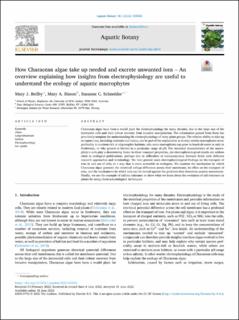| dc.contributor.author | Beilby, Mary J. | |
| dc.contributor.author | Bisson, Mary A. | |
| dc.contributor.author | Schneider, Susanne Claudia | |
| dc.date.accessioned | 2022-10-26T05:56:33Z | |
| dc.date.available | 2022-10-26T05:56:33Z | |
| dc.date.created | 2022-09-15T14:32:03Z | |
| dc.date.issued | 2022 | |
| dc.identifier.citation | Aquatic Botany. 2022, 181, 103542. | en_US |
| dc.identifier.issn | 0304-3770 | |
| dc.identifier.uri | https://hdl.handle.net/11250/3028272 | |
| dc.description.abstract | Characean algae have been a model plant for electrophysiology for many decades, due to the large size of the internodal cells and their robust recovery from invasive manipulation. The information gained from them has provided a template for understanding the electrophysiology of many plant groups. The relative ability to take up or export ions, including nutrients and toxins, can be part of the explanation as to why certain macrophytes occur preferably in nutrient-rich or oligotrophic habitats, why some macrophytes can grow in brackish water or only in freshwater, or why growth is limited to a particular range of pH. The electrical characteristics of the macrophyte’s cells play a determining factor in these transport properties, yet electrophysiological results are seldom cited in ecological publications, perhaps due to difficulties of communication between fields with different research approaches and terminology. We here present main electrophysiological findings on the transport of ions in and out of cells, in a way that is more accessible to ecologists. We examine the mechanism by which Characean algae generate the electrical voltage difference across their membrane, its effect on the transport of ions, and the mechanisms by which ions can be moved against the gradients that determine passive movements. Finally, we use the example of salinity tolerance to show what we learn about the evolution of salt tolerance in plants by using electrophysiological techniques. | en_US |
| dc.language.iso | eng | en_US |
| dc.publisher | Elsevier | en_US |
| dc.rights | Navngivelse 4.0 Internasjonal | * |
| dc.rights.uri | http://creativecommons.org/licenses/by/4.0/deed.no | * |
| dc.title | How Characean algae take up needed and excrete unwanted ions – An overview explaining how insights from electrophysiology are useful to understand the ecology of aquatic macrophytes | en_US |
| dc.type | Peer reviewed | en_US |
| dc.type | Journal article | en_US |
| dc.description.version | publishedVersion | en_US |
| dc.rights.holder | © 2022 The Authors | en_US |
| dc.source.pagenumber | 1-9 | en_US |
| dc.source.volume | 181 | en_US |
| dc.source.journal | Aquatic Botany | en_US |
| dc.identifier.doi | 10.1016/j.aquabot.2022.103542 | |
| dc.identifier.cristin | 2052109 | |
| dc.source.articlenumber | 103542 | en_US |
| cristin.ispublished | true | |
| cristin.fulltext | original | |
| cristin.qualitycode | 1 | |

